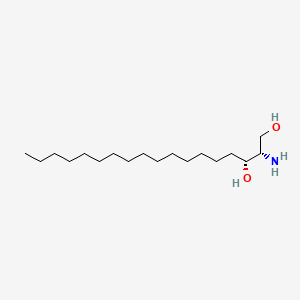Sphinganine
Sphinganine is a lipid of Sphingolipids (SP) class. Sphinganine is associated with abnormalities such as Sphingolipidoses, CLEFT LIP, CONGENITAL HEALED, Aortic aneurysm, familial thoracic 4, Morphologically altered structure and Atherosclerosis. The involved functions are known as Transcription, Genetic, Signal, Muscle Contraction, biological adaptation to stress and Gene Expression. Sphinganine often locates in Tissue membrane, Membrane, Protoplasm, Plasma membrane and Cytoplasmic. The associated genes with Sphinganine are SLC33A1 gene, HM13 gene, P4HTM gene, SPHK1 gene and SPHK2 gene. The related lipids are Sphingolipids, Phosphatidylserines, Sterols, Fatty Acids and inositolphosphorylceramide. The related experimental models are Mouse Model and Knock-out.
References related to genes published in J. Lipid Res.
| PMID | Journal | Published Date | Author | Title |
|---|---|---|---|---|
| 9788256 | J. Lipid Res. | 1998 | Yano M et al. | Quantitative analysis of ceramide molecular species by high performance liquid chromatography. |
| 12777464 | J. Lipid Res. | 2003 | Dragusin M et al. | Metabolism of the unnatural anticancer lipid safingol, L-threo-dihydrosphingosine, in cultured cells. |
| 12897185 | J. Lipid Res. | 2003 | Lieser B et al. | Quantification of sphingosine and sphinganine from crude lipid extracts by HPLC electrospray ionization tandem mass spectrometry. |
| 16061940 | J. Lipid Res. | 2005 | Tani M et al. | Mechanisms of sphingosine and sphingosine 1-phosphate generation in human platelets. |
| 22661289 | J. Lipid Res. | 2012 | Kim HJ et al. | A fluorescent assay for ceramide synthase activity. |
| 20228220 | J. Lipid Res. | 2010 | Scherer M et al. | A rapid and quantitative LC-MS/MS method to profile sphingolipids. |
| 19786568 | J. Lipid Res. | 2010 | Park H et al. | Transcript profiling and lipidomic analysis of ceramide subspecies in mouse embryonic stem cells and embryoid bodies. |
